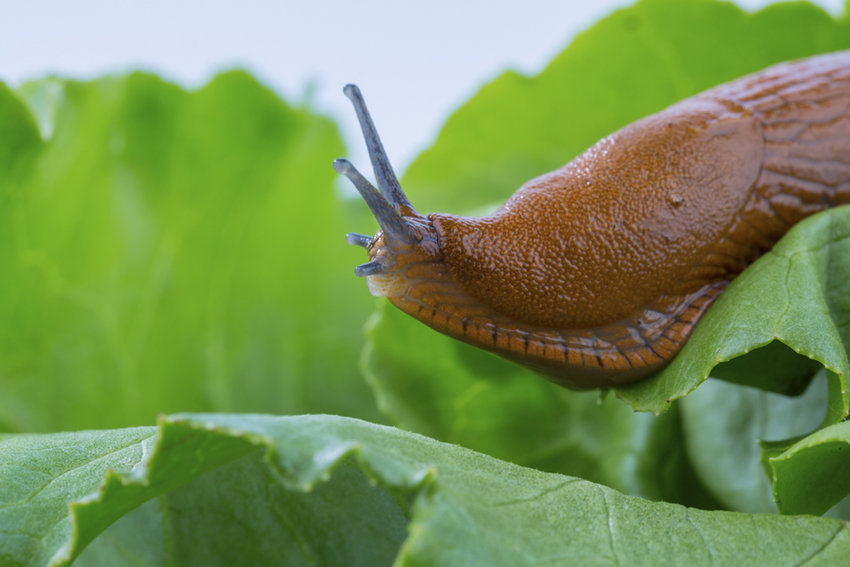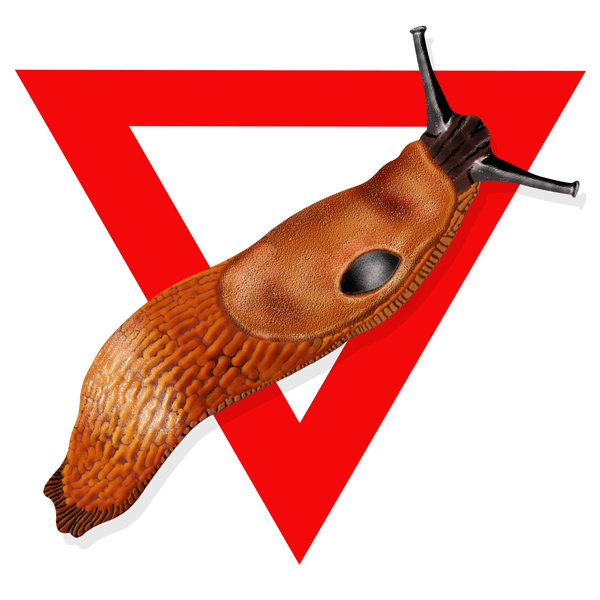 Slugs are different things to different people: a gardener’s nightmare, a forest worker breaking down decomposing forest vegetation, the mascot of the University of California Santa Cruz, the namesake of the annual Northwest Trek Slug Fest. Slug stories abound, as borne witness by members of the Key Pen Gardeners Facebook Group. Stan Moffett’s mother wrote a book for her granddaughter, “The Sex Life of Slugs.” Lisa Larson remembered a neighbor siphoning gas from his car to use in his mower and ending up with a slug in his throat. Others attested to ducks and snakes as a sure way to keep the population down. Janice Fox’s mother took her and her cousins out slug hunting with flashlights at night. And more than one admitted collecting wayward slugs and carrying them to the woods since they had no heart for slug murder. Understanding the habits of these voracious gastropod mollusks — they can eat up to triple their weight each day — can help to combat them. The banana slug, native to the region, lives in forests and is the second largest slug in the world, growing as large as 10 inches. They play an important role in helping break down forest debris and mostly feed on fungi and detritus. Other native slugs bear names like taildropper and warty jumping-slug. They, too, stick to their forest habitat and don’t feast on crops or gardens. Garden slugs, the bane of so many a gardener’s existence, are imports from Europe and Asia. Slugs have two pairs of tentacles, the upper sensitive to light and the lower sensitive to touch and smell. The mouth on the bottom of the head is filled with tiny replaceable teeth. The mantle, over the front of the slug, has a respiratory opening and under the mantle are the genital opening and the anus. The rest of the slug provides locomotion. Slugs produce four kinds of slime: a thick slime to help move on rough or slippery surfaces, a thinner slime to help move on normal terrain, another to entice a mate, and one that is especially thick and stinky for protection. Slugs are hermaphrodites, and when they mate each one supplies sperm to the other. They can mate year-round, but the most activity takes place in fall and spring. Newly hatched slugs eat algae and fungi and do not eat slug baits. Slugs prefer the dark and wet, coming out at night to feed and hiding under rocks and debris during the day. They don’t like moving over abrasive materials. They may become dormant in dry summer months. They spend much of their time underground; during the summer only 5 percent of the population will be above ground at a given time. Armed with these facts, a gardener can successfully combat these slimy pests. For best results an integrated approach is recommended. That means making your garden less attractive to slugs, attracting natural predators such as ducks, snakes and shrews, paying attention to when you water, and considering traps and baits. Raking the first few inches of garden soil in late summer and early fall will expose slug eggs to air. Ornamental gardens have an edge with plants that slugs don’t like. These include foxglove, anemones, rhododendrons, sedum, impatiens and ferns. Evening watering creates a slug heaven at night; morning is preferred. Slugs are deterred by surrounding the perimeter with such things as lava rock, eggshells, lint from the dryer, wood ashes or rosemary sprigs. Diatomaceous earth is a good barrier, but only until it gets wet. Copper tape around a planter will keep slugs away. If these deterrents fail, the next step is a trap. One popular DIY model is a plastic container with 1-inch diameter holes cut near the rim, buried with the holes at surface height. Filled with beer or a solution of 2 tablespoons of flour, ½ teaspoon of brewer’s yeast, 1 teaspoon of sugar and 2 cups of water. As a last resort, slug bait can help get rid of slugs. Those with iron phosphate instead of metaldehyde are safer around children, pets and other animals. Using them at the right time of the slug life cycle is important. Treating slugs before they begin to lay eggs in the fall, when temperatures cool and rains begin, and in the spring, when adults emerge, is most effective. Pierce County Master Gardeners recommend using bait in April and August, the months that start with an “A.” Oregon State University recommends a slightly later fall application, in September and early October. Information for this article came from Pierce County Master Gardeners; Cori Carlton, Master Gardener Program Coordinator for Thurston County and her Slug University curriculum; and Oregon State University.
Slugs are different things to different people: a gardener’s nightmare, a forest worker breaking down decomposing forest vegetation, the mascot of the University of California Santa Cruz, the namesake of the annual Northwest Trek Slug Fest. Slug stories abound, as borne witness by members of the Key Pen Gardeners Facebook Group. Stan Moffett’s mother wrote a book for her granddaughter, “The Sex Life of Slugs.” Lisa Larson remembered a neighbor siphoning gas from his car to use in his mower and ending up with a slug in his throat. Others attested to ducks and snakes as a sure way to keep the population down. Janice Fox’s mother took her and her cousins out slug hunting with flashlights at night. And more than one admitted collecting wayward slugs and carrying them to the woods since they had no heart for slug murder. Understanding the habits of these voracious gastropod mollusks — they can eat up to triple their weight each day — can help to combat them. The banana slug, native to the region, lives in forests and is the second largest slug in the world, growing as large as 10 inches. They play an important role in helping break down forest debris and mostly feed on fungi and detritus. Other native slugs bear names like taildropper and warty jumping-slug. They, too, stick to their forest habitat and don’t feast on crops or gardens. Garden slugs, the bane of so many a gardener’s existence, are imports from Europe and Asia. Slugs have two pairs of tentacles, the upper sensitive to light and the lower sensitive to touch and smell. The mouth on the bottom of the head is filled with tiny replaceable teeth. The mantle, over the front of the slug, has a respiratory opening and under the mantle are the genital opening and the anus. The rest of the slug provides locomotion. Slugs produce four kinds of slime: a thick slime to help move on rough or slippery surfaces, a thinner slime to help move on normal terrain, another to entice a mate, and one that is especially thick and stinky for protection. Slugs are hermaphrodites, and when they mate each one supplies sperm to the other. They can mate year-round, but the most activity takes place in fall and spring. Newly hatched slugs eat algae and fungi and do not eat slug baits. Slugs prefer the dark and wet, coming out at night to feed and hiding under rocks and debris during the day. They don’t like moving over abrasive materials. They may become dormant in dry summer months. They spend much of their time underground; during the summer only 5 percent of the population will be above ground at a given time. Armed with these facts, a gardener can successfully combat these slimy pests. For best results an integrated approach is recommended. That means making your garden less attractive to slugs, attracting natural predators such as ducks, snakes and shrews, paying attention to when you water, and considering traps and baits. Raking the first few inches of garden soil in late summer and early fall will expose slug eggs to air. Ornamental gardens have an edge with plants that slugs don’t like. These include foxglove, anemones, rhododendrons, sedum, impatiens and ferns. Evening watering creates a slug heaven at night; morning is preferred. Slugs are deterred by surrounding the perimeter with such things as lava rock, eggshells, lint from the dryer, wood ashes or rosemary sprigs. Diatomaceous earth is a good barrier, but only until it gets wet. Copper tape around a planter will keep slugs away. If these deterrents fail, the next step is a trap. One popular DIY model is a plastic container with 1-inch diameter holes cut near the rim, buried with the holes at surface height. Filled with beer or a solution of 2 tablespoons of flour, ½ teaspoon of brewer’s yeast, 1 teaspoon of sugar and 2 cups of water. As a last resort, slug bait can help get rid of slugs. Those with iron phosphate instead of metaldehyde are safer around children, pets and other animals. Using them at the right time of the slug life cycle is important. Treating slugs before they begin to lay eggs in the fall, when temperatures cool and rains begin, and in the spring, when adults emerge, is most effective. Pierce County Master Gardeners recommend using bait in April and August, the months that start with an “A.” Oregon State University recommends a slightly later fall application, in September and early October. Information for this article came from Pierce County Master Gardeners; Cori Carlton, Master Gardener Program Coordinator for Thurston County and her Slug University curriculum; and Oregon State University. 
UNDERWRITTEN BY THE FUND FOR NONPROFIT NEWS (NEWSMATCH) AT THE MIAMI FOUNDATION, THE ANGEL GUILD, ADVERTISERS, DONORS AND PEOPLE WHO SUPPORT INDEPENDENT, NONPROFIT LOCAL NEWS